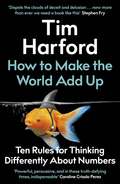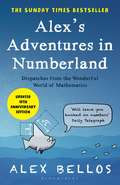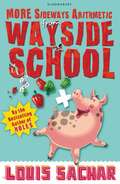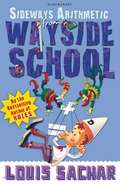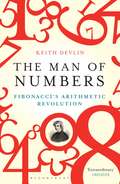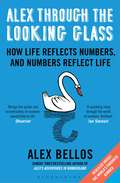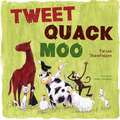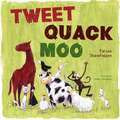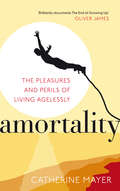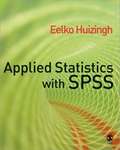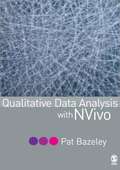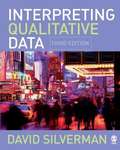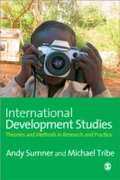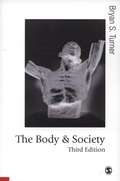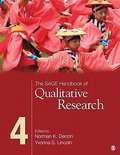- Table View
- List View
Maths Skills for A Level Economics (PDF)
by Jim LawrenceSuitable for all awarding bodies, this practical handbook clearly addresses the mathematical elements of the A Level Economics specifications. Within each topic double-page spreads cover the mathematical skills your students will need to practise to fully understand that topic.
How to Make the World Add Up: Ten Rules for Thinking Differently About Numbers
by Tim Harford'If you aren't in love with stats before reading this book, you will be by the time you're done. Powerful, persuasive, and in these truth-defying times, indispensable'Caroline Criado Perez, author of Invisible Women'Nobody makes the statistics of everyday life more fascinating and enjoyable than Tim Harford'Bill Bryson'Fabulously readable, lucid, witty and authoritative . . . Every politician and journalist should be made to read this book, but everyone else will get so much pleasure and draw so much strength from the joyful way it dispels the clouds of deceit and delusion' Stephen Fry'Wise, humane and, above all, illuminating. Nobody is better on statistics and numbers - and how to make sense of them'Matthew SyedWhen was the last time you read a grand statement, accompanied by a large number, and wondered whether it could really be true? Statistics are vital in helping us tell stories - we see them in the papers, on social media, and we hear them used in everyday conversation - and yet we doubt them more than ever.But numbers - in the right hands - have the power to change the world for the better. Contrary to popular belief, good statistics are not a trick, although they are a kind of magic. Good statistics are not smoke and mirrors; in fact, they help us see more clearly. Good statistics are like a telescope for an astronomer, a microscope for a bacteriologist, or an X-ray for a radiologist. If we are willing to let them, good statistics help us see things about the world around us and about ourselves - both large and small - that we would not be able to see in any other way.In How to Make the World Add Up, Tim Harford draws on his experience as both an economist and presenter of the BBC's radio show 'More or Less'. He takes us deep into the world of disinformation and obfuscation, bad research and misplaced motivation to find those priceless jewels of data and analysis that make communicating with numbers worthwhile. Harford's characters range from the art forger who conned the Nazis to the stripper who fell in love with the most powerful congressman in Washington, to famous data detectives such as John Maynard Keynes, Daniel Kahneman and Florence Nightingale. He reveals how we can evaluate the claims that surround us with confidence, curiosity and a healthy level of scepticism.Using ten simple rules for understanding numbers - plus one golden rule - this extraordinarily insightful book shows how if we keep our wits about us, thinking carefully about the way numbers are sourced and presented, we can look around us and see with crystal clarity how the world adds up.
Alex's Adventures in Numberland: Dispatches From The Wonderful World Of Mathematics
by Alex BellosThe world of maths can seem mind-boggling, irrelevant and, let's face it, boring. This groundbreaking book reclaims maths from the geeks. Mathematical ideas underpin just about everything in our lives: from the surprising geometry of the 50p piece to how probability can help you win in any casino. In search of weird and wonderful mathematical phenomena, Alex Bellos travels across the globe and meets the world's fastest mental calculators in Germany and a startlingly numerate chimpanzee in Japan. Packed with fascinating, eye-opening anecdotes, Alex's Adventures in Numberland is an exhilarating cocktail of history, reportage and mathematical proofs that will leave you awestruck.
More Sideways Arithmetic from Wayside School: More Than 50 Brainteasing Math Puzzles (Wayside School Ser.)
by Louis SacharWelcome back to maths class at Wayside School. How much is PEPPERS + PIG LIPS? If Jenny's shirt has sparkles on it, will Todd have egg in his hair? These Sideways Arithmetic problems may look puzzling at first, but you can use real maths to solve them, and the answers are perfectly logical. There are lots of clues and hints, plus all the answers are right there in the book. Best of all, the children you have read about in the other books about Wayside School are here to help you! Try solving these, and more than fifty other maths brainteasers, along with the kids from Mrs. Jewls's class. You'll learn a lot about maths but you'll be laughing too much to notice!
Sideways Arithmetic from Wayside School: More than 50 mindboggling maths puzzles! - Rejacketed (Wayside School Ser.)
by Louis SacharWhy does elf + elf = fool?How many meals will Miss Mush, the lunch teacher, have to cook for the food to taste as bad as it smells?These Sideways Arithmetic problems may look puzzling at first, but you can use real maths to solve them, and the answers are right there in the book. There are lots of clues and hints; plus all the answers are in the back of the book. Best of all, all the kids you read about in the other books about Wayside School are here to help you!Try solving this, and more than fifty other maths brainteasers, along with the kids from Mrs Jewls's class. You'll learn a lot about maths but you'll be laughing too much to notice!
The Man of Numbers: Fibonacci's Arithmetic Revolution
by Keith DevlinIn 1202, a 32-year old Italian finished one of the most influential books of all time, which introduced modern arithmetic to Western Europe. Devised in India in the seventh and eighth centuries and brought to North Africa by Muslim traders, the Hindu-Arabic system helped transform the West into the dominant force in science, technology, and commerce, leaving behind Muslim cultures which had long known it but had failed to see its potential. The young Italian, Leonardo of Pisa (better known today as Fibonacci), had learned the Hindu number system when he traveled to North Africa with his father, a customs agent. The book he created was Liber abbaci, the 'Book of Calculation', and the revolution that followed its publication was enormous. Arithmetic made it possible for ordinary people to buy and sell goods, convert currencies, and keep accurate records of possessions more readily than ever before. Liber abbaci's publication led directly to large-scale international commerce and the scientific revolution of the Renaissance. Yet despite the ubiquity of his discoveries, Leonardo of Pisa remains an enigma. His name is best known today in association with an exercise in Liber abbaci whose solution gives rise to a sequence of numbers - the Fibonacci sequence - used by some to predict the rise and fall of financial markets, and evident in myriad biological structures. In The Man of Numbers, Keith Devlin recreates the life and enduring legacy of an overlooked genius, and in the process makes clear how central numbers and mathematics are to our daily lives.
Alex Through the Looking Glass: How Life Reflects Numbers, and Numbers Reflect Life
by Alex BellosFrom triangles, rotations and power laws, to fractals, cones and curves, bestselling author Alex Bellos takes you on a journey of mathematical discovery with his signature wit, engaging stories and limitless enthusiasm. As he narrates a series of eye-opening encounters with lively personalities all over the world, Alex demonstrates how numbers have come to be our friends, are fascinating and extremely accessible, and how they have changed our world.He turns even the dreaded calculus into an easy-to-grasp mathematical exposition, and sifts through over 30,000 survey submissions to reveal the world's favourite number. In Germany, he meets the engineer who designed the first roller-coaster loop, whilst in India he joins the world's highly numerate community at the International Congress of Mathematicians. He explores the wonders behind the Game of Life program, and explains mathematical logic, growth and negative numbers. Stateside, he hangs out with a private detective in Oregon and meets the mathematician who looks for universes from his garage in Illinois.Read this captivating book, and you won't realise that you're learning about complex concepts. Alex will get you hooked on maths as he delves deep into humankind's turbulent relationship with numbers, and proves just how much fun we can have with them.
Tweet, Quack Moo
by Fatima Sharafeddine Hassan ZahreddineWhat's that noise? Tweet, Quack, Moo is a playful read for children learning to count to ten and imitate animal sounds. From barking dogs to clucking chickens, there's so many noises to count!
Tweet, Quack Moo
by Fatima Sharafeddine Hassan ZahreddineWhat's that noise? Tweet, Quack, Moo is a playful read for children learning to count to ten and imitate animal sounds. From barking dogs to clucking chickens, there's so many noises to count!
Everybody Lies: The New York Times Bestseller
by Seth Stephens-DavidowitzTHE NEW YORK TIMES BESTSELLERAN ECONOMIST BOOK OF THE YEARA NEW STATESMAN BOOK OF THE YEAR'This book is about a whole new way of studying the mind ... Endlessly fascinating' Steven Pinker'A whirlwind tour of the modern human psyche' EconomistEverybody lies, to friends, lovers, doctors, pollsters – and to themselves. In Internet searches, however, people confess the truth.Insightful, funny and always surprising, Everybody Lies explores how this huge collection of data, unprecedented in human history, could just be the most important ever collected. It offers astonishing insights into the human psyche, revealing the biases deeply embedded within us, the questions we're afraid to ask that might be essential to our well-being, and the information we can use to change our culture for the better.
Amortality: The Pleasures and Perils of Living Agelessly
by Catherine MayerDoes your real age match the age you feel?When do we reach middle age?When, if ever, are we old?The way we age and the way we perceive age has changed radically. As we embrace new experiences, relationships and gadgets, we barely stop to look at our watches let alone consider whether our behaviour is 'age appropriate'.In this provocative and timely book, Catherine Mayer looks at the forces that created amortality - the term she coined to describe the phenomenon of living agelessly. As she follows this social epidemic through generations and across continents, she reveals its profound impact on society, our careers, our families and ourselves.Why be defined by numbers?Are you amortal?
Perfect Numerical and Logical Test Results
by Joanna Moutafi Marianna Moutafi-Have you been asked to sit a numerical or logical reasoning test?-Do you need some help preparing for the questions you'll be asked?-Do you want to make sure you perform to the best of your abilities?Perfect Numerical and Logical Test Results is an essential guide for anyone who wants to secure their ideal job. Written by two experts in occupational and clinical psychology, it explains how numerical and logical tests work, gives helpful pointers to help you prepare for the big day, and provides professionally constructed sample questions so that you can practise at home. It also contains an in-depth section on online testing - the route that more and more recruiters are choosing to take. Whether you're a graduate looking to take the first step on the career ladder, or you're planning an all-important job change, Perfect Numerical and Logical Test Results has everything you need to make sure you stand out from the competition.The Perfect series is a range of practical guides that give clear and straightforward advice on everything from getting your first job to choosing your baby's name. Written by experienced authors offering tried-and-tested tips, each book contains all you need to get it right first time.
Maths for Mums and Dads: The Teenage Years
by Mike Askew Rob EastawayIn a new edition, fully revised and updated to reflect key new curriculum topics and methods, Maths for Mums and Dads guides you through the basics of primary school maths and covers the dilemmas and problems you are likely to be confronted with, including:* number bonds, place value and decimals* long multiplication and division * fractions, percentages and decimals* basic geometry, shapes, symmetry and angles* data-handling, combinations and chanceComplete with sample questions, mock exam papers and examples of children's errors, Maths for Mums and Dads will challenge and reassure in equal measure.
Developing Thinking In Geometry (Published In Association With The Open University Ser. (PDF))
by John Mason Sue Johnston-Wilder'Geometry is often given less time in the teaching timetable than other aspects of mathematics. This book encourages practitioners to think about and raise its profile, indeed achieving what its title suggest' - Primary Practice `This creative, innovative and fascinating book/CD package is one you "MUST BUY". All prospective, new and experienced teachers of mathematics can use it to transform their teaching. All readers can use it to reignite their fascination with mathematics' - Professor Sylvia Johnson, Sheffield Hallam University 'This book exudes activity and interactivity. Moreover, it provides challenge in the context of a significant pedagogy, one that is not just present but actually made explicit. It is undoubtedly a book to learn geometry with, but also one to learn to think more deeply about geometry, about its nature and essence, and also about its teaching and learning' - David Pimm Developing Thinking in Geometry enables teachers and their support staff to experience and teach geometric thinking. As well as discussing key teaching principles, the book and accompanying interactive CD include many activities that encourage readers to extend their own learning, and consequently their teaching practices. The book is constructed around the following key themes: - invariance; - language and points of view; - reasoning using invariance; - visualising and representing. These themes draw on teaching principles developed by the team at the Open University's Centre for Mathematics Education which has a 20-year track record of innovative approaches to teaching and learning geometry. This is a 'must have' text for all primary mathematics specialists, secondary and Further Education mathematics teachers and their support staff. Anyone who wishes to create an understanding and enthusiasm for geometry based upon firm research and effective practice, will enjoy this book. This is the course reader for the Open University Course ME627 Developing Geometric Thinking
Applied Statistics with SPSS (PDF)
by Eelko HuizinghAccessibly written and easy to use, Applied Statistics Using SPSS is an all-in-one self-study guide to SPSS and do-it-yourself guide to statistics. Based around the needs of undergraduate students embarking on their own research project, the text's self-help style is designed to boost the skills and confidence of those that will need to use SPSS in the course of doing their research project. The book is pedagogically well developed and contains many screen dumps and exercises, glossary terms and worked examples. Divided into two parts, Applied Statistics Using SPSS covers : 1. A self-study guide for learning how to use SPSS. 2. A reference guide for selecting the appropriate statistical technique and a stepwise do-it-yourself guide for analysing data and interpreting the results. 3. Readers of the book can download the SPSS data file that is used for most of the examples throughout the book here. Geared explicitly for undergraduate needs, this is an easy to follow SPSS book that should provide a step-by-step guide to research design and data analysis using SPSS.
Qualitative Data Analysis with Nvivo (PDF)
by Patricia BazeleyDoing Qualitative Data Analysis with NVivo is essential reading for anyone thinking of using their computer to help analyze qualitative data. With 15 years experience in computer-assisted analysis of qualitative and mixed-mode data, Patricia Bazeley is one of the leaders in the use and teaching of NVivo software.
Interpreting Qualitative Data: Methods For Analyzing Talk, Text And Interaction (PDF)
by David Silverman'Reading Silverman's user-friendly volume is like sitting in his seminars with all eyes and ears, reflecting on each stage of an ongoing small-scale study under his guidance with his invisible presence. His insights in doing research and the interdisciplinary nature of this book will definitely help his readers to survive academically' - Discourse amp; Communication.
Children's Mathematics: Making Marks, Making Meaning
by Elizabeth CarruthersVisit the author's own website here! Children's Mathematics Network'In Case Study 5 (a grassroots 'Children's Mathematics Network group') the initiative supported the participants in their professional change by giving them a space for the detailed and joint consideration of children's mathematical thinking. Another significant feature of this initiative is its focus on careful consideration and analysis of children's mathematics, and the ways in which professionals can support and encourage the children's mathematical thinking and reasoning The standard of the mathematical understanding, thinking and reasoning that the displays revealed was far higher than the specified curriculum objectives for children of this age' - Researching Effective CPD in Mathematics Education (RECME) project: (NCETM, 2009) 'The review also plays great score by play-based learning of a mathematical nature, and makes specific recommendations regarding early mark-making as a precursor to abstract mathematical symbolism'. Section 115 features children's mathematical graphics and emphasises: 'The role of mark-making in children's cognitive development is set out in the taxonomy (Carruthers and Worthington, 2006)'. The report recommends that 'local authorities, leaders, managers and head teachers should provide a culture with a significant focus on mathematical mark-making' and 'a learning environment that encourages children to choose to use their own mathematical graphics to support their mathematical thinking and processes' - The Williams Maths Review: (DCSF, 2008) At the very heart of the success of the book is the authors' ability to see mathematics through young children's eyes by listening to and reflecting on the constant efforts made by children to make sense of their world. This is a liberating book which proposes that the teaching of mathematics could and should be a highly creative and enjoyable proceess' - Branwen Llewelyn Jones, Early Years Consultant at PACE Ltd / TACTYC'Ground breaking... To single out any one chapter would be unfair because there is something thought-provoking and inspirational throughout. If you want to expand your understanding upwards and outwards then get a copy soon' - Times Educational Supplement'I first read Children's Mathematics, Making Marks, Making Meaning a couple of years ago and it had an immediate impact on my own thinking and teaching, and the work I do with trainee teachers. I'm sure you will find it compelling reading too. I think it has the potential to change, in a fundamental way, how we think about early mathematical development' - Lynne McClure, Editor, Math Co-ordiator's File, Mathematics Association'In their exceptionally readable and informative book, Children's Mathematics, Making Marks, Making Meaning Carruthers and Worthington (2006) draw attention to one of the main goals of early years teaching, that is, to help children make links between the mathematics they have already encountered (and continue to engage with) at home and the more abstract mathematics of the school. These authors suggest that by encouraging children to represent mathematical ideas in their own ways and, crucially, by talking to the pupils about the marks they have made, we are given a e;windowe; onto their thinking that may otherwise be inaccessible' - Liz Pumphrey, NRICHThis book draws on the authors' many years of teaching children aged three to eight years and also on their extensive research with children in the home, nursery and school. The authors explain the development and range of young children's mathematical marks and visual representations, showing how children make mental connections between their own early marks and subsequent abstract mathematical symbolism, and go on to develop their own written methods. Combining theory and practice, this acclaimed book demonstrates how children's own mathematical graphics are highly creative and show deep levels of thinking. The authors show how this is the key to success in school mathematics and to higher levels of achievement. The authors are winners of TACT...
Video in Qualitative Research: Analysing Social Interaction in Everyday Life (PDF)
by Jon Hindmarsh Paul Luff Christian HeathVideo provides unprecedented opportunities for social science research, enabling fine-grained analysis of social organisation, culture and communication. Video in Qualitative Research provides practical guidance for students and academics on how to use video in qualitative research, how to address the problems and issues that arise in undertaking video-based field studies and how to subject video recordings to detailed scrutiny and analysis. Heath, Hindmarsh and Luff consider the ethical and practical issues that arise in recording and gathering data as well as how video enables new and distinctive ways of presenting insights, observations and findings to both academic and practitioner audiences. The book is illustrated throughout with a wide range of case material drawn from the authors own research projects, and these cases serve to situate the practical and methodological guidance offered by the book into real research scenarios. Video in Qualitative Research is an invaluable guide for students and researchers across the social sciences thinking of using video as part of their research. Christian Heath is Professor of Work and Organisation, Kings College London Jon Hindmarsh is Reader in Work Practice and Technology, Kings College London Paul Luff is Professor in Organisations and Technology, Kings College London
Video in Qualitative Research: Analysing Social Interaction in Everyday Life (PDF)
by Jon Hindmarsh Paul Luff Christian HeathVideo provides unprecedented opportunities for social science research, enabling fine-grained analysis of social organisation, culture and communication. Video in Qualitative Research provides practical guidance for students and academics on how to use video in qualitative research, how to address the problems and issues that arise in undertaking video-based field studies and how to subject video recordings to detailed scrutiny and analysis. Heath, Hindmarsh and Luff consider the ethical and practical issues that arise in recording and gathering data as well as how video enables new and distinctive ways of presenting insights, observations and findings to both academic and practitioner audiences. The book is illustrated throughout with a wide range of case material drawn from the authors own research projects, and these cases serve to situate the practical and methodological guidance offered by the book into real research scenarios. Video in Qualitative Research is an invaluable guide for students and researchers across the social sciences thinking of using video as part of their research. Christian Heath is Professor of Work and Organisation, Kings College London Jon Hindmarsh is Reader in Work Practice and Technology, Kings College London Paul Luff is Professor in Organisations and Technology, Kings College London
International Development Studies: Theories and Methods in Research and Practice (PDF)
by Andrew Sumner Michael A Tribe'A sure-footed and self-confident book, ambitious in scope, authoritative in execution and practical in its implications' - Simon Maxwell, Director, Overseas Development Institute, London
The Body and Society: Explorations in Social Theory (PDF)
by Bryan S. TurnerThis is a fully revised edition of a book that may fairly claim to have re-opened the sociology of the body as a legitimate area of enquiry. Providing an unparalleled guide to all aspects of the subject, each chapter has been revised and updated while the book contains new material that reflects both recent changes in the field and Turner's developing position on the centrality of vulnerability.
Reworking Qualitative Data: The Possibility of Secondary Analysis (PDF)
by Janet HeatonWhat is qualitative secondary analysis? How can it be most effectively applied in social research?
Research Design: Qualitative, Quantitative, And Mixed Methods Approaches
by John W. CreswellThe Third Edition of the bestselling text Research Design enables readers to compare three approaches to research - qualitative, quantitative and mixed methods - in a single research methods text. The book presents these three approaches side by side within the context of the process of research from the beginning steps of philosophical assumptions to the writing and presenting of research. The Third Edition: - presents the preliminary steps of using philosophical assumptions in the beginning of the book - provides an expanded discussion on ethical issues - emphasizes new Web-based technologies for literature searches - offers updated information about mixed-methods research procedures - contains a glossary of terms.
The SAGE Handbook of Qualitative Research (4th edition)
by Denzin. Norman K. Yvonna LincolnPresenting the state of the art for the theory and practice of qualitative inquiry, this landmark Handbook has been a publishing phenomenon in the human sciences since it first released in 1994. As with earlier editions, the Fourth Edition is virtually a new volume.

